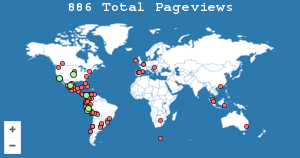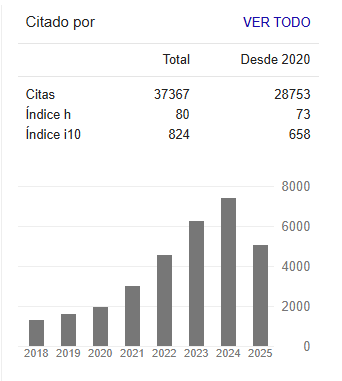A deep view of dynamics of teleworking in Panama
Resumen
Teleworking has accelerated in the last three years, although the advantages of this modality can be valuable, its application still requires legal and practical aspects in order to carry out the activities in an agile and appropriate manner. In this sense, its objective was to analyze of telework modality in Panama. To this end, a study was conducted using the positivist paradigm with quantitative, non-experimental, cross-sectional field methodology, with the instrument structured in four dimensions. The research design was descriptive-correlational, field-based, applied, using a stratified probability sample, using the economically active population of the country as an estimate. The sample was calculated using Bravo’s (1994) formula, with a sampling error of 5%, resulting in a total number of 399 participants from different economic sectors where teleworking is possible, such as education, information and communication technology, banking and insurance. The overall conclusion of the study is that the introduction of teleworking in Panama has been effective. However, the impact of teleworking on employees’ well-being can be considered negative and it is recommended to incorporate best practices to mitigate the impact in terms of labor legislation and workers’ well-being in terms of mental health.
Citas
Aguiléra, A., Lethiais, V., Rallet, A. y Proulhac, L. (2016). Home-based telework in France: Characteristics, barriers and perspectives. París, Francia. Retrieved from: https://www.researchgate.net/publication/305845172_Home-based_telework_in_France_Characteristics_barriers_and_perspectives
Anderson, N. (2013). Concepto “Bring Your Own Device (BYOD)” de Cisco. Libertad de elección de los dispositivos sin sacrificar la red de TI. Cisco Systems, Inc. Retrieved from: https://www.cisco.com/c/dam/global/es_es/assets/pdf/byod_cisco_device-freedom_white-paper_es-eu.pdf
Arumdani, K., Soetjipto, B. E., & Sopiah, S. (2024). The Impact of Telework Work-Family Conflict and Work Overload on Work Stress During the Covid-19 Pandemic 2020-2022 (Systematic Literature Review and Bibliometric Analysis). JMKSP (Jurnal Manajemen, Kepemimpinan, Dan Supervisi Pendidikan), 9(1), 396–414. https://doi.org/10.31851/jmksp.v9i1.13810
Barbosa, V. (2013). Teletrabajo, Liderar y Trabajar en Equipos a distancia. Dunken.
Bayazitova, R., Assel, K., and Anton, V. (2023). “Working from Home, Telework, Equality and the Right to Privacy: A Study in Kazakhstan” Social Sciences, 12(1), 42. https://doi.org/10.3390/socsci12010042
Bravo, S. (1994). Técnicas de investigación social, Teoría y ejercicios. Madrid: Editorial Paraninf. https://abcproyecto.files.wordpress.com/2018/11/sierra-bravo-tecnicas-de-investigacion-social.pdf
Bridi, M. A. (2022) Teletrabalho para além da pandemia. In: Proni TTRW, Almeida NB, editores. Trabalho, meio ambiente e meio ambiente do trabalho: novos horizontes dos direitos humanos no universo laboral. Campinas: Universidade Estadual de Campinas; p. 155-70.
Bridi, M. A., Tropia, P. V., & Vazquez, B. V. (2024). Telework and health in the context of the COVID-19 pandemic. Revista Brasileira de Saúde Ocupacional, 49. https://doi.org/10.1590/2317-6369/34122en2024v49edcinq3
Bridi, M. A., Tropia, P. V., & Vazquez, B. V. (2024). Telework and health in the context of the COVID-19 pandemic. Revista Brasileira de Saúde Ocupacional, 49. https://doi.org/10.1590/2317-6369/34122en2024v49edcinq3
Buira, J. (2012). El teletrabajo: entre el mito y la realidad. ProQuest Ebook Central, http://ebookcentral.proquest.com/lib/ulatinasp/detail.action?docID=3207870.
Chan, C., Oey, N. E., & Tan, E.-K. (2020). Mental health of scientists in the time of COVID-19. Brain, Behavior, and Immunity, 88, 956. https://doi.org/10.1016/j.bbi.2020.05.039
Chinnaiah P.M, & P., S. (2021). (2021). Challenges of working from homein persistent covid-19 environment. International Research Journal of Business Studies, 14(1), 85–97. https://doi.org/10.21632/irjbs.14.1.85-97
Decreto Ejecutivo N° 133. Asamblea Nacional de Panamá. Panamá, República de Panamá, 16 de septiembre de 2020. https://www.gacetaoficial.gob.pa/pdfTemp/29115_A/GacetaNo_29115a_20200917.pdf
Eurofound and the International Labour Office (2017). Working anytime, anywhere: The effects on the world of work, Publications Office of the European Union, Luxembourg, and the International Labour Office, Geneva.
Fana, M., Milasi, S., Napierala, J., Fernández-Macías, E., & Vázquez, I. G. (2020). Telework, work organisation and job quality during the COVID-19 crisis: a qualitative study (No. ٢٠٢٠/١١). JRC Working Papers Series on Labour, Education and Technology.
García-Camino, Burgos, Mercedes. (2001). Teletrabajo y discapacidad, UNED - Universidad Nacional de Educación a Distancia. ProQuest Ebook Central, https://ebookcentral.proquest.com/lib/ulatinasp/detail.action?docID=3201168.
Huws, U. (2014). Vida, trabalho e valor no século XXI: desfazendo o nó. Caderno CRH, 27(70). https://doi.org/10.9771/ccrh.v27i70.19628
International Labour Organization (2020). COVID-19 and the world of work. https://www.ilo.org/global/topics/coronavirus/lang--en/index.htm.
Irwin, F. (2004). Gaining the Air Quality and Climate Benefit from Telework. Environmental Protection Agency and the AT&T Foundation. Retrieved from: http://pdf.wri.org/teleworkguide.pdf
Kohont, A., & Ignjatović, M. (2022). Organizational support of working from home: Aftermath of COVID-19 from the perspective of workers and leaders. Sustainability, 14(9), 5107. https://doi.org/10.3390/su14095107
Lapierre, L. M., van Steenbergen, E. F., Peeters, M. C. W., & Kluwer, E. S. (2016). Juggling work and family responsibilities when involuntarily working more from home: A multiwave study of financial sales professionals. Journal of Organizational Behavior, 37(6), 804–822. https://doi.org/10.1002/job.2075
Law N° 126. Asamblea Nacional de Panamá. Panamá, República de Panamá, 18 de febrero de 2020. https://www.gacetaoficial.gob.pa/pdfTemp/28965_A/GacetaNo_28965a_20200219.pdf
Lund, S., Madgavkar, A., Manyika, J., & Smit, S. (2020, noviembre 23). What’s next for remote work: An analysis of 2,000 tasks, 800 jobs, and nine countries. Mckinsey.com; McKinsey & Company. https://www.mckinsey.com/featured-insights/future-of-work/whats-next-for-remote-work-an-analysis-of-2000-tasks-800-jobs-and-nine-countries
Malakyan, P. (2020). Digital leader-followership for the digital age: A north American perspective. En Digital Leadership - A New Leadership Style for the 21st Century. IntechOpen.
Maruyama, T., & Tietze, S. (2012). From anxiety to assurance: concerns and outcomes of telework. Personnel Review, 41(4), 450–469. https://doi.org/10.1108/00483481211229375
Ministerio de la Presidencia de Panamá (2019, Noviembre 14). Google ratifica a Panamá como “hub digital” de la región. https://www.presidencia.gob.pa/Noticias/Con-inversion-millonaria-Google-ratifica-a-Panama-como-hub-digital-de-la-region#:~:text=Google%2C%20empresa%20l%C3%ADder%20en%20tecnolog%C3%ADa,que%20ofrece%20el%20istmo%20y
Moglie, M. J., Marcovich, I., Corradi, J., Carpaneto Freixas, A. E., Gallino, S., Plazas, P. V., Bouzat, C., Lipovsek, M., & Elgoyhen, A. B. (2021). Loss of choline agonism in the inner ear hair cell nicotinic acetylcholine receptor linked to the α10 subunit. Frontiers in molecular neuroscience, 14. https://doi.org/10.3389/fnmol.2021.639720
Naden, C. (2020). COVID-19: Addressing workplace challenges on world day for safety and health at work. https://www.iso.org/news/ref2504.html
Nakrošienė, A., Bučiūnienė, I., & Goštautaitė, B. (2019). Working from home: characteristics and outcomes of telework. International Journal of Manpower, 40(1), 87–101. https://doi.org/10.1108/ijm-07-2017-0172
Neri, M., Bonato, R., Zappalà, S., Torre, T., Scapolan, A., Mizzau, L. Maggi, B. (2017). Smart working: una prospettiva critica. TAO Digital Library. Retrieved from: http://amsacta.unibo.it/5717/1/SmartWorking.pdf
Pan American Health Oragnization –PAHO (2020). Organizational strengthening of BIREME in emergency teleworking due to COVID-19. https://www.paho.org/en/news/18-6-2020-organizational-strengthening-bireme-emergency-teleworking-due-covid-19
Parker, S. K., Morgeson, F. P., & Johns, G. (2017). One hundred years of work design research: Looking back and looking forward. Journal of Applied Psychology, 102(3), 403–420. https://doi.org/10.1037/apl0000106
Queiroz, M. M., Ivanov, D., Dolgui, A., & Fosso Wamba, S. (2022). Impacts of epidemic outbreaks on supply chains: mapping a research agenda amid the COVID-19 pandemic through a structured literature review. Annals of Operations Research, 319(1), 1159–1196. https://doi.org/10.1007/s10479-020-03685-7
Raišienė, A. G., Rapuano, V., Varkulevičiūtė, K., & Stachová, K. (2020). Working from home—who is happy? A survey of Lithuania’s employees during the COVID-19 quarantine period. Sustainability, 12(13), 5332. https://doi.org/10.3390/su12135332
Rubbini, N. I. (2012) Los riesgos psicosociales en el teletrabajo [en línea]. VII Jornadas de Sociología de la UNLP, 5 al 7 de diciembre de 2012, La Plata, Argentina. En Memoria Académica. Disponible en: http://www.memoria.fahce.unlp.edu.ar/trab_eventos/ev.2237/ev.2237.pdf
Selma, J. (2015). “El teletrabajo, ¿una solución?”. [Facultad de Ciencias Sociales y Jurídicas de Elche. Trabajo Grado en Relaciones Laborales y Recursos Humanos]. http://dspace.umh.es/bitstream/11000/2522/1/Selma%20Lajarin%2C%20Jesus.pdf
Tatay, C. (2022). El teletrabajo y el desplazamiento de trabajadores a través de plataformas digitales. E-revista internacional de la proteccion social, X, 140–169. https://doi.org/10.12795/e-rips.2022.mon.07
Tavares, A.I. (2015). Telework and Health Effects Review, and a Research Framework Proposal. Munich Personal RePEc Archive Paper; University Library of Munich. https://mpra.ub.uni-muenchen.de/71648/1/MPRA_paper_71648.pdf
The World Health Organization- WHO (2020). Doing What Matters in Times of Stress. https://www.who.int/publications/i/item/9789240003927
Thulin, E., Vilhelmson, B., & Johansson, M. (2019). New telework, time pressure, and time use control in everyday life. Sustainability, 11(11), 3067. https://doi.org/10.3390/su11113067
Trziszka, M. (2018). Scientific Quarterly. Organization and Management, 3(43). https://doi.org/10.29119/1899-6116.2018.43.10
United Nations – UN (2020). Policy brief: Covid-19 and the need for action on mental health. https://unsdg.un.org/sites/default/files/2020-05/UN-Policy-Brief-COVID-19-and-mental-health.pdf
Urrutia, A. (2000), Teletrabajo y comunicación interna: ¿incompatibilidad? http://www.bocc.ubi.pt/pag/urrutia-amaia-teletrabajo.pdf
Vilaseca, J. (2004). El teletreball a Catalunya: conceptes, tipologies, mètriques i polítiques. Consell de Treball, Economic I Social de Catalunya CTESC.
Vilhelmson, B., & Thulin, E. (2016). Who and where are the flexible workers? Exploring the current diffusion of telework in Sweden. New Technology, Work and Employment, 31(1), 77–96. https://doi.org/10.1111/ntwe.12060
Xiao, H., Zhang, Y., Kong, D., Li, S., & Yang, N. (2020). Social capital and sleep quality in individuals who self-isolated for 14 days during the Coronavirus disease 2019 (COVID-19) outbreak in January 2020 in China. Medical Science Monitor: International Medical Journal of Experimental and Clinical Research, 26. https://doi.org/10.12659/msm.923921

Esta obra está bajo licencia internacional Creative Commons Reconocimiento-NoComercial-CompartirIgual 4.0.








.png)






























